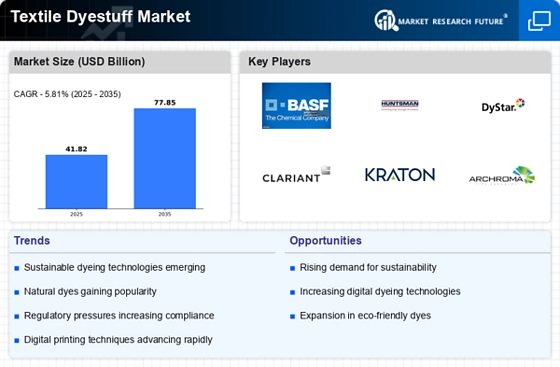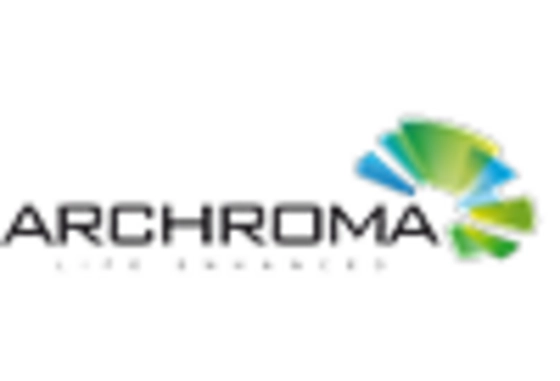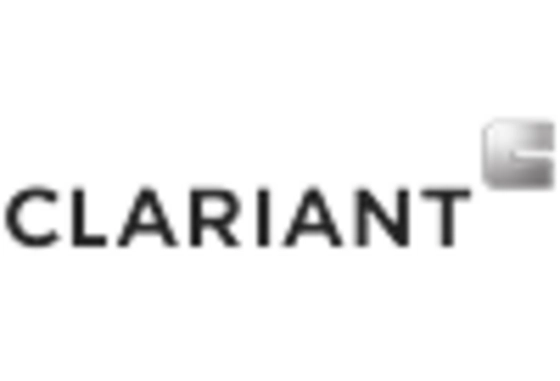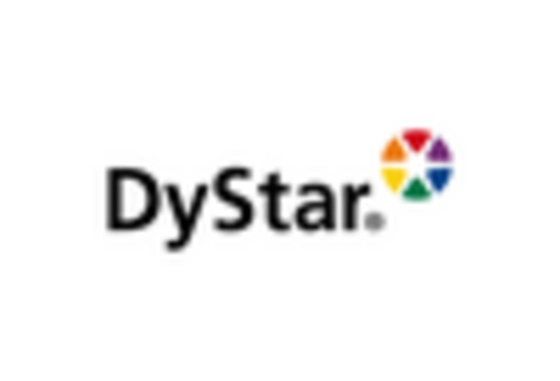Regulatory Compliance
Regulatory compliance is becoming increasingly critical in the Textile Dyestuff Market, as governments and organizations implement stricter regulations regarding chemical usage and environmental impact. Manufacturers are required to adhere to guidelines that limit the use of hazardous substances in dyes, which is driving innovation towards safer alternatives. Compliance with these regulations not only ensures the safety of consumers but also enhances the reputation of brands within the market. As a result, companies are investing in research to develop compliant dye formulations that meet both regulatory standards and consumer expectations. This focus on compliance is likely to shape the future landscape of the Textile Dyestuff Market, as businesses strive to align with evolving regulations and consumer demands.
Sustainability Initiatives
The increasing emphasis on sustainability within the Textile Dyestuff Market is driving demand for eco-friendly dyes and processes. Consumers and manufacturers alike are becoming more aware of the environmental impact of traditional dyeing methods, which often involve harmful chemicals and excessive water usage. As a result, there is a notable shift towards natural dyes and sustainable practices. According to recent data, the market for sustainable textile dyes is projected to grow at a compound annual growth rate of approximately 8% over the next five years. This trend not only aligns with consumer preferences but also encourages manufacturers to innovate and adopt greener technologies, thereby enhancing their competitive edge in the Textile Dyestuff Market.
Technological Advancements
Technological advancements are playing a pivotal role in shaping the Textile Dyestuff Market. Innovations in dyeing technologies, such as digital printing and waterless dyeing techniques, are revolutionizing the way textiles are colored. These technologies not only reduce water consumption but also minimize waste and energy usage, making them more appealing to environmentally conscious consumers. Furthermore, the integration of artificial intelligence and automation in dye production processes is enhancing efficiency and precision. As a result, manufacturers are able to produce high-quality dyes at a lower cost, which is likely to stimulate growth in the Textile Dyestuff Market. The adoption of these advanced technologies is expected to increase, potentially leading to a more sustainable and efficient dyeing process.
Customization and Performance
The demand for customization in the Textile Dyestuff Market is on the rise, driven by consumer preferences for unique and personalized products. As fashion trends evolve, brands are increasingly seeking to differentiate themselves through customized dye solutions that cater to specific aesthetic and performance requirements. This trend is particularly evident in the sportswear and activewear segments, where performance attributes such as colorfastness and durability are paramount. Market data indicates that the customization segment is expected to account for a significant share of the overall textile dye market, with a projected growth rate of around 6% annually. This shift towards tailored solutions is prompting manufacturers to invest in research and development, thereby enhancing their offerings in the Textile Dyestuff Market.
Rising Demand from Emerging Markets
The rising demand from emerging markets is significantly influencing the Textile Dyestuff Market. As economies in these regions continue to grow, there is an increasing appetite for textiles and apparel, which in turn drives the need for dyes. Countries in Asia and Africa are witnessing a surge in textile production, fueled by both local consumption and export opportunities. Market analysis suggests that the demand for textile dyes in these regions is expected to grow at a rate of approximately 7% over the next few years. This growth presents opportunities for manufacturers to expand their operations and cater to the unique needs of these markets. Consequently, the Textile Dyestuff Market is likely to experience a shift in focus towards these emerging economies, which could reshape competitive dynamics.


















Leave a Comment